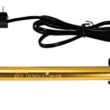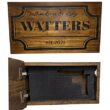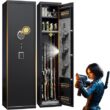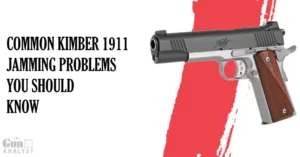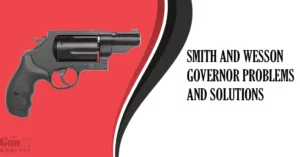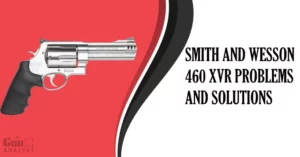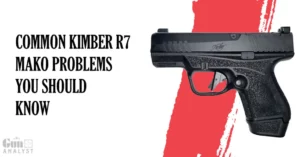The 43C from Smith & Wesson is one of the lightest J-Frame revolvers produced. These compact revolvers are as dependable as they are simple to operate and capable of firing full-power rounds.
This dependable and highly sought-after pocket gun is not without flaws, though. Common problems include misfiring, the trigger being too heavy, the cylinder being jammed up, debris and buildups on the forcing cone, weak primer strikes, and the ejector not working.
Completely read this article to learn about the Smith & Wesson 43C problems and how to fix them quickly and easily.
Features & Specifications of Smith and Wesson 43C:
- Grip : Synthetic
- Product weight : 11.5 ounces
- Product length : 6.25 inches
- Capacity : 8 rounds
- Frame Material : Aluminum Alloy
- Cylinder Material : Aluminum Alloy
- Barrel Material : Stainless Steel

Common Smith and Wesson 43C Problems and Solutions
Quick Overview of the Problems and Solutions
| Problem | Solutions |
| Failure to Fire | Inspect the ejector rod and clean it thoroughly. |
| Heavy Trigger | Test the function of the trigger, and check the striker channel. |
| Locked Cylinder Completely | Tighten the extractor rod. Replace the crane if needed. |
| Dirt on Forcing Cone | Use remover to clean the place. |
| Light Primer Strikes | Clean the firing pin. If it is damaged, replace it. |
| Ejection Issue | Replace your recoil spring. Tighten the extractor. |
1. Failure to fire
Failure to fire is a typical issue with the S&W 43C. It misfires several times. Sometimes, misfires result in no firing. In certain instances, it may have hit, but did not fire.
If there was a difficulty with tight case ejection or ejection rod, the hammer may have nicked the hammer shroud before contacting the pin.
The Fix:
Examine and thoroughly clean the ejector rod to resolve the issue. Repair the hammer. Replace the ammunition you’re using.
If the problem still happens after you change the ammunition, you should change the leaf spring. By changing the leaf spring, the power and force of the spring will increase, letting the hammer hit with more force.
Check the revolver’s leaf spring strain screw. If the tension screw is not tight enough, the firing pin may hit softly.
2. Heavy Trigger
There are problems with the trigger on the 43C. The trigger would become incredibly weighty.
The trigger press of 43C would typically rotate the cylinder but never drop the hammer.
The Fix:
It may be wise to examine the striker channel. Complete disassembly and lubrication will solve your problem.
3. Locked Cylinder
While shooting with a 43C, you may encounter a few complications, such as when you attempt to close the cylinder and it does not close completely. The cylinder may be compromised.
So, one possible explanation is that the cylinder couldn’t seal because the gas ring had broken and moved forward, getting stuck between the cylinder and the frame.
Maybe the extractor rod has become loose. If the crane of your S&W 43C is bent, the cylinder will not close and the gun will not lock up.
The Fix:
To fix the problem, tighten the extractor rod that may be loosened. You might want to change the cylinder. Fix the crane that is bent replace if needed.
4. Dirt on Forcing Cone
The top strap of the S&W 43C tends to get dirty quickly, especially where it meets the forcing cone.
Also, it was spitting a lot. The lead buildup is rather crazy for just having 70 mini magazines in the chamber.
The Fix:
Make use of Lewis Lead Remover by twisting the rubber stopper while the mesh eats away at the steel. Clean the area after soaking it and letting it sit for a while.
5. Light Primer Strikes
Another problem with the S&W 43C is that the priming often strikes too lightly. Misfires and hang fires are often the result of light priming strikes.
They still won’t happen every time, and not with every type of ammunition, but their frequency will increase.
An indication of a gun malfunction known as a “light strike,” which can happen repeatedly owing to mechanical defects or muck accumulation, is a far less pronounced depression on the suspect primer.
Ammunition failure occurs when a primer is not properly manufactured and therefore fails to fire when struck normally.
The Fix:
The repair may require cleaning, new springs, or new parts to replace old, broken ones. Professional assistance may be required for proper fit.
6. Ejection Issue
The S&W 43C’s ejector is faulty, and the gun may become so jammed that you are unable to fire it. To release shells from the ejector, you may need to tap it with a mallet.
This could be the result of using lower-pressure rounds, a defective production run, or a shoddy handload. The recoil spring is another typical root cause. An overly-tight recoil spring will cause the slide to cycle before the spent case is ejected from the gun.
The Fix:
Ensure that the weight of the recoil spring is appropriate for your ammunition. Lighter loads necessitate lighter springs, while heavier loads necessitate stiffer springs.
Additionally, you may need to replace your recoil spring if it is worn. Possible requirement to tighten the extractor. Field strip and inspect the firearm. If the extractor is excessively slack or appears worn, it may require tightening or replacement.
User Feedback on Smith and Wesson 43C
The Smith & Wesson 43C is a compact revolver with a powerful bullet and a user-friendly, dependable design. Moreover, this firearm is seen differently by different users.
User feedback suggests the Smith & Wesson 43C is among the lightest J-Frame revolvers available. Many reviewers and users have lauded the S&W 43C for its lightweight. The first thing everyone noticed when they picked it up was how light it was.
An individual reviewer stated that this rifle is intended for very close-range work. In this case, it should function wonderfully.
According to another source, the Model 43C is easy-to-fire, although the trigger pull is hefty and slightly gritty.
Moreover, the majority of users love this pistol because of its features and easy-to-fire characteristics.
Top 3 Alternative Revolvers of Smith and Wesson 43C
Ruger LCR
Compared to the Ruger LCR, the Smith & Wesson 43C now has a much more refined and substantial trigger. In comparison to the LCR, the 43C is shorter in length.
Since the regular LCR grips are larger than the ones on the 43C, the 43C is more convenient to carry concealed.
S&W 351 C
Both the S&W 43C and 351C are J-frame, double-action revolvers. However, while the 43C’s trigger is adequate, the 351C’s is heavy; both revolvers have synthetic grips; their length is 6.25 inches; their weight is 11.5 ounces, and their frame material is aluminum alloy.
S&W Bodyguard 38
The Bodyguard 38 has a stainless-steel barrel and is lightweight. An aluminum alloy is used for the frames of both the 43C and the Bodyguard 38, and they both have synthetic grips.
Also, both barrels measure in at a uniform 1.875″ in length. Therefore, the S&W Bodyguard 38 revolver may be a viable alternative to the S&W 43C.
Frequently Asked Questions (FAQs)
How much does a Smith & Wesson 43C weigh?
The Model 43C weighs 11.5 oz.
Is the S&W 43C a type J frame?
The Smith & Wesson 43C is the J-frame revolver from Smith & Wesson.
How much ammunition can a Smith & Wesson 43C revolver hold?
A Smith & Wesson model 43C revolver cylinder can store eight bullets.
What is the lightest 22LR revolver?
Smith & Wesson’s 43C is one of the lightest J-Frame revolvers made.
Conclusion
Overall, this pistol is an excellent option for anyone seeking a lightweight and simple-to-fire weapon. However, you may encounter the most prevalent Smith & Wesson 43C problems discussed in this article.
Follow my instructions if you’re having any of these problems. Hopefully, this information will assist you in fixing your problems.



